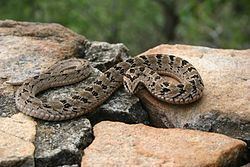Kingdom Animalia Subphylum Vertebrata Suborder Serpentes Scientific name Causinae Rank Subfamily | Phylum Chordata Order Squamata Genus Causus
Wagler, 1830 Higher classification Vipers Clutch size Causus rhombeatus: 24 | |
 | ||
Speed Causus rhombeatus: 3.3 km/h Length Causus rhombeatus: 10 – 12 cm Lower classifications Causus rhombeatus, Causus resimus | ||
The Causinae are a monotypic subfamily of venomous vipers found only in sub-Saharan Africa. It was created for the genus Causus, a group considered to be among the most primitive members of the family Viperidae based on head scalation, oviparity, venom apparatus, and because they have round pupils. However, this is contradicted by recent molecular studies. Six species are currently recognized. They are commonly known as night adders.
Contents
Description
These snakes are fairly stout, never growing to more than 1 m (3.3 ft) in total length.
As opposed to most vipers, where the head is distinct from the neck and covered with small scales, in Causus the head is only slightly distinct from the neck and covered with 9 large, symmetrical head shields. Also, the eyes have round pupils instead of elliptical ones like other vipers. The rostral scale is broad, sometimes pointed or upturned. The nostril is located between two nasals and an internasal. The frontal and supraocular scales are long. A loreal scale is present, separating the nasal and preoculars. The suboculars are separated from the supralabials. The mandible has splenial and angular elements.
The fangs are different, too. Unlike other vipers, no hinge action occurs where the prefrontal bone engages the frontal. However, since the maxillary bones rotate almost as far, the fangs can still be erected. The fangs themselves are relatively short. A fine line, or suture, is also present along the length of the fang, representing the vestigial edge where the groove lips meet (from incomplete fang canal closure).
The body is cylindrical or slightly depressed and moderately slender. The dorsal scales are smooth or weakly keeled with apical pits. The ventral scales are rounded, and the anal plate is single. The tail is short, and the subcaudals can be either single or paired.
Among the viperids, another unique characteristic of this genus is several species have venom glands that are not confined to the temporal area as with most vipers, but are exceptionally long and extend well down the neck. These venom glands, located on either side of the spine, may be up to 10 cm in length, with long ducts connecting them to the fangs.
Other internal differences also set the Causinae apart: they have unusually long kidneys, a well-developed tracheal lung with two tracheal arteries, and the liver overlaps the tip of the heart.
Geographic range
The Causinae are found in sub-Saharan Africa.
Behavior
Despite their common name, this genus is active during the day, as well as at night. When disturbed, they will engage in a ferocious hissing and puffing threat display. They may lift the first part of their bodies off the ground in a coil and make a powerful swiping strike; juveniles have been known to come off the ground. Others specimens may raise the first part of their bodies off the ground, flattening their necks and moving forward, tongue extended, like a small cobra. The rather frantic strikes are often combined with attempts to quickly glide away.
Feeding
Their diet consists almost exclusively of toads and frogs. Gluttony has been reported; when prey is abundant, they may eat until they are literally unable to swallow any more food.
Reproduction
All Causus species lay eggs (oviparous), which among vipers is considered to be a more primitive trait, though not unique. The average clutch consists of some two dozen eggs that require an incubation period of about four months. Hatchlings are 4-5 in (10-12.5 cm) in total length (body + tail).
Captivity
They are best kept in dry and well-ventilated cages that include places to hide, fresh water, and a basking spot slightly warmer than the rest of the cage (26 to 27°C). They will accept killed mice as food, but as they are voracious feeders, care must be taken to prevent obesity by overfeeding.
Venom
In spite of their enormously developed venom glands, night adders do not always use them to subdue their prey. The venom would act fast enough, but often they simply seize and swallow their prey, instead.
Venom can be very serious and in at least one bite to a child had to have a fasciotomy. We see a number of small dogs dying and having limbs amputated. A bite from a large individual on a small child could potentially be fatal - please do not underestimate the venom of this snake.
Causus venom is weaker than that of puff adder. Envenomation normally causes only local pain and swelling. Antivenin treatment should not be necessary. Nevertheless, South African polyvalent serum is known to be effective against the venom of at least two species.
No recent deaths have been reported due to this species. Earlier reports of fatalities were based on anecdotal evidence; the species involved likely were not properly identified or the cases were grossly mismanaged.
Species
T) Type species.
Taxonomy
A long-standing tendency among herpetologists was to make assumptions regarding the phylogenetic position of this group. McDiarmid et al. suggested the consensus among the experts in 1999 was that Causus was basal to all viperids, so deserved a separate subfamily. However, two more recent molecular phylogenetic studies have shown Causus is not only not basal to all viperids, but in fact appears to be nested within the viperines. Consequently, recognition of the subfamily Causinae is inappropriate.
